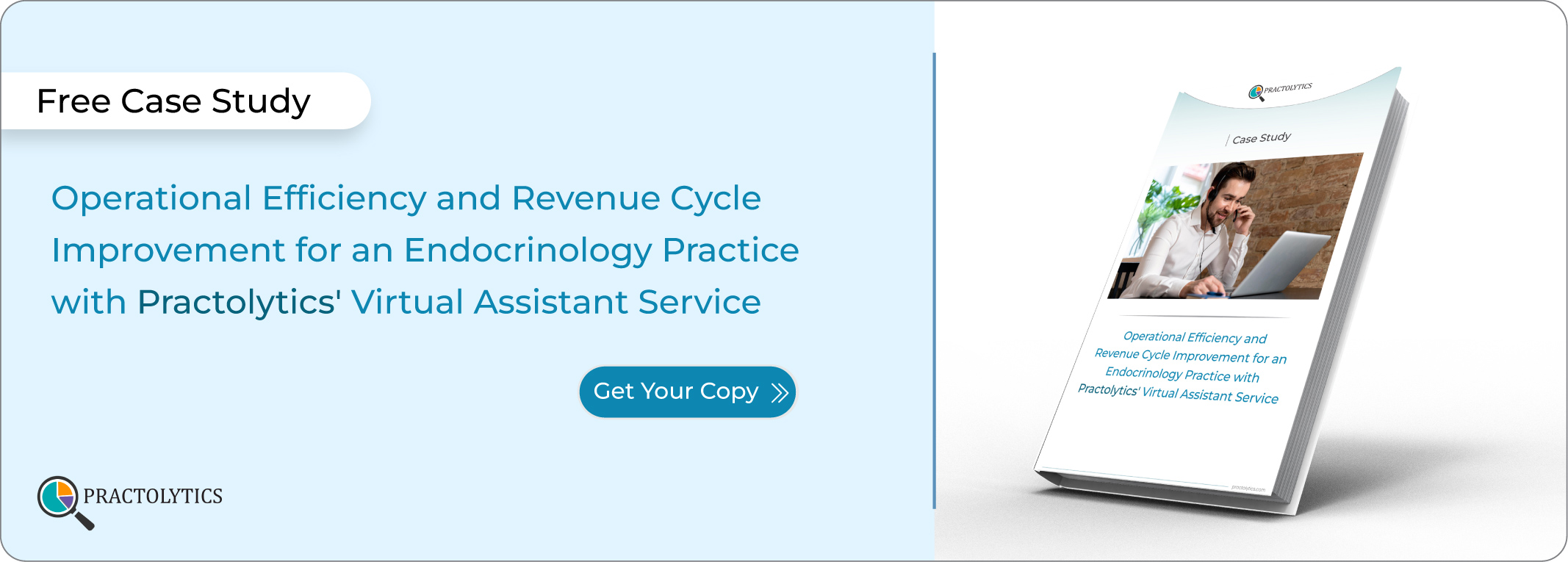Virtual Medical Assistants Limits in Clinical Support
Virtual medical assistants (VMAs) handle essential administrative tasks such as scheduling, billing, and patient follow-ups, streamlining the overall healthcare process. However, Virtual Medical Assistants Limits in Clinical Support become evident when it comes to direct patient care. VMAs cannot diagnose diseases, manage complex medical conditions, or provide clinical advice. While they help reduce operational costs and save time, they also face key challenges, including data dependency, emotional limitations, and compliance concerns. This blog discusses these limitations and provides insights on maintaining operational compliance and patient safety while using VMAs effectively. Practolytics showcases how to achieve the right balance between automation and human expertise to enhance healthcare outcomes.
Table of Contents
What Are Virtual Medical Assistants’ Limitations in Clinical Support or Advice?
Virtual medical assistant, or VMAs, are improving healthcare. They take care of things like scheduling appointments, verifying insurance, billing, and corresponding with patients via the internet. As a result, fewer additional office workers are required. As clinics lean into tech, VMAs keep operations smooth.
Recent numbers show 68% of U.S. healthcare teams now use virtual assistants—and adoption keeps climbing. And why? They reduce the administrative load, simplify operations, and save money.
VMAs do have limitations, though. They are unable to advise patients or make medical calls. Sticking to these boundaries keeps things legal, safe, and high-quality. Healthcare executives should make prudent use of VMAs by concentrating on patient care and maintaining compliance.
The practical benefits, significant drawbacks, and clever ways to incorporate VMAs into your clinic’s daily operations are all covered in this review.
The Basics: What Virtual Medical Assistants Can Do Well
Let’s discuss what VMAs can do before discussing what they can’t do. Regular administrative tasks are handled by virtual medical assistant services, saving your team time and effort. Typically, they manage tasks including:
- Setting appointments and sending reminders
- Answering patient questions (like office hours or needed forms)
- Managing emails, calls, and messages
- Verify the patient’s insurance coverage.
- Assistance with authorizations for insurance
- Send follow-up reminders and refill alerts; update patient records (with clinician oversight);
- Help with insurance claims and billing.
Key Limitation #1: No Diagnosis or Treatment Advice
Virtual medical assistants have clear limits: they can’t diagnose illnesses or offer medical advice. This is important to understand.
Even advanced AI systems shouldn’t:
- Guess illnesses based on symptoms
- Recommend meds, doses, or treatments
- Decide if someone needs emergency care
- Approve or reject treatment plans
These tasks require a licensed healthcare provider’s judgment. If a VMA tries to handle them, it risks legal issues for patients and clinics.
Real-World Example:
A lawsuit was filed against a US healthcare company in 2023. Their AI helper wrongly called a patient’s symptoms “not urgent.” The delay in care resulted in hospitalization. Even though they used a third-party VMA, the provider was fully responsible.
Key Limitation #2: Limited Understanding of Complex Medical Language
Most VMAs—even ones built for healthcare—have trouble with complex medical info. For example:
- They often miss small differences in symptoms.
- They might skip key details in patient records.
- They struggle to understand lab results or scan reports.
Even AI helpers face limits because medical language keeps changing. They may mess up if they’re working with old info.
Here’s why that matters:
A recent survey shows 72% of doctors worry AI tools might miss key details or oversimplify patient cases during critical tasks like updating records or deciding how urgent a problem is.
Key Limitation #3: Compliance and Privacy Risks in Sensitive Conversations
Sensitive health topics may arise during patient discussions. Virtual medical assistants, or VMAs, deal with privacy issues such as
- Sharing info with family members.
- Discussing mental health concerns.
- Managing sexual/reproductive health details.
- Responding to abuse or self-harm reports.
VMAs are not trained to spot urgent health or legal risks, even when following privacy rules. This creates patient safety concerns and potential lawsuits.
Key Limitation #4: Lack of Emotional Intelligence in Patient Care
Clinical care isn’t just about technical skills—it needs human connection. Current virtual tools miss this mark.
They often fail to notice when patients feel stressed or frustrated.
Their scripted replies can be cold and impersonal.
They don’t build trust or emotional support.
For patients with ongoing health issues or sensitive diagnoses, this gap lowers satisfaction and worsens outcomes.
Key Finding: An AMA study shows 64% of patients still prefer discussing health concerns with humans, even with digital options available.
Key Limitation #5: Reliance on Data Accuracy and Quality
Virtual assistants (VMAs) need good data to work well. If the information you give them is:
- Missing pieces
- Entered wrong
- Not current
- Or confusing
The VMA might mess up scheduling, records, or medical billing. For example, if allergy details are missing, it could schedule conflicting treatments or send unsafe medication instructions. Remember: VMAs can’t spot missing info or check if data is accurate on their own—that’s your medical team’s job.
Key Limitation #6: Not All VMAs Are Integrated with Clinical Workflows
Even with fancy tech, many virtual medical assistants don’t link properly with hospitals’ main systems. This creates real headaches:
- Patient records update too slowly.
- Lab and pharmacy systems don’t talk to each other.
Employees squander time entering the same data into multiple systems. Without seeing the full picture, care teams struggle to coordinate effectively.
These tools can’t support urgent medical decisions without seamless connections to electronic health records (EHRs). Instead of becoming vital for patient care, they remain secondary devices.
Key Limitation #7: Regulatory and Liability Boundaries
Everywhere, there are stringent regulations in the healthcare industry. The authority to make medical decisions is clearly limited by laws such as HIPAA and CMS standards. If virtual medical assistants cross these lines, healthcare providers face big risks—both for patient safety and legal trouble. Doctors are always fully responsible for care under their license, even if errors come from virtual staff. That’s why most healthcare groups keep VMAs focused on admin tasks or very specific nonclinical work. This approach keeps things compliant and lowers legal risks.
Trends and Future: Can Technology Close the Gap?
The future of virtual healthcare is shifting quickly. Here’s what to expect by 2025:
1. AI Assistants for Doctors
AI tools will help doctors find health problems quickly. But doctors stay in charge. They make the final call on diagnoses.
2. Smarter Advice Systems
Virtual assistants will warn about treatment risks and suggest proven options, while doctors keep full control.
3. Voice-Controlled Records
Doctors will update patient records using voice commands, but human judgment remains crucial for understanding the data.
4. Hybrid Care Approach
Routine tasks can be automated safely. This frees up clinicians to focus on complex cases.
The virtual healthcare assistant market is growing fast:
- $1.6 billion in 2024
- $6.5 billion by 2030
Best Practices: Using VMAs Safely and Effectively
Clinics should use virtual medical assistants to boost benefits safely. Here’s how:
- Establish boundaries: Clearly define the capabilities and limitations of VMAs.
- Make help easy to get: If a medical question comes up that the VMA can’t handle, it should go straight to a real doctor or nurse right away.
- Train everyone: Make sure both your staff and your patients understand how VMAs work and their limitations.
- Connect your systems: Link VMAs to your patient records and billing software to cut down on paperwork errors.
- Check in often: Regularly look at how VMAs are interacting to make sure they’re accurate, following rules, and not causing problems.
Doing these things helps clinics use VMAs effectively and safely.
Conclusion: VMAs Are Valuable—But Not a Replacement for Clinicians
Virtual medical assistants (VMAs) make healthcare run smoothly. They take care of admin tasks, help patients faster, and speed up billing. Remember: VMAs don’t prescribe medicine or give treatment advice.
Their built-in limits are safety features—they protect patients, staff, and your practice. Used right, VMAs free up your medical team to focus on what they do best: giving great care.
Practolytics: Smart Help Without the Hassle
Want the benefits of virtual help without the risks? Practolytics delivers. We blend smart tech with real human support to give you:
- Full billing and payment cycle management
- Quicker claims with instant insurance checks
- HIPAA-safe support that locks down your data
- Smooth EHR connections and workflow fixes
- Flexible 24/7 operational help
Practolytics cuts admin work so your team spends more time with patients.
Ready to boost your practice?
Contact Practolytics today. We’ll set up VMAs that make your work faster, safer, and more profitable.
Read More – From Chaos to Efficiency: A Small Practice’s Journey with a Virtual Assistant
Talk to Medical Billing Expert Today — Get a Free Demo Now!






